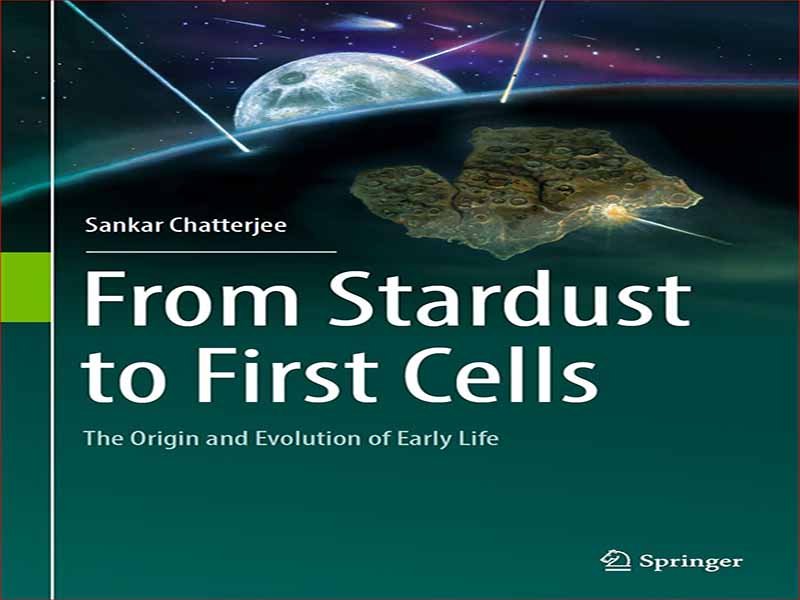- عنوان کتاب: From Stardust to First Cells / The Origin and Evolution of Early Life
- نویسنده: Sankar Chatterjee
- حوزه: زیست محیطی
- سال انتشار: 2023
- تعداد صفحه: 273
- زبان اصلی: انگلیسی
- نوع فایل: pdf
- حجم فایل: 22.9 مگابایت
منشا حیات از غیر حیات روی زمین یک راز ماندگار است. حل آن نه تنها نیاز انسان ما را برای درک این مهمترین دغدغههای وجودی کاهش میدهد، بلکه ما را در جستجوی طولانی و در حال گسترش ما برای حیات فراتر از زمین راهنمایی میکند. مطالعه منشا حیات روی زمین چالش برانگیز است زیرا حداقل چهار میلیارد سال پیش آغاز شد و تنها آثار زمینشناسی وسوسهانگیز به شکل میکروفسیلها و استروماتولیتها در قدیمیترین سنگها بر جای گذاشت. سابقه ای از فرآیندهای پری بیوتیک حفظ نشده است. با این حال، به نظر میرسد که حیات روی زمین نتیجه یک رویداد مجزا نبوده، بلکه یک امر ضروری کیهانی و ویژگی سیارهای است که در زمین جوان ظاهر شده است. گمانه زنی در مورد مسیر تاریخی دقیق از بی جان به جاندار – هویت بلوک های سازنده حیات موجود در مکان های فیزیکی خاص روی زمین پری بیوتیک همراه با ساختارهای شیمیایی مراحل میانی احتمالی در مسیر زندگی – به سرعت با استفاده از تکنیک ها و داده ها اصلاح می شود. برخاسته از بسیاری از شاگردان علمی مختلف. این کتاب پیشرفتهای اخیر در اختر زیستشناسی را شرح میدهد که به درک منشأ حیات از دیدگاه کیهانی کمک کرده است. اینکه چگونه زندگی از این مقدار اندک ماده فیزیکی تنوع زیادی ایجاد کرد، قابل توجه است. داروین این دیدگاه از زندگی را در آخرین جمله از منشاء گونهها جاودانه کرد: «از ابتدایی بسیار ساده، زیباترین و شگفتانگیزترین شکلهای بیپایان شکل گرفتهاند و در حال تکامل هستند.» تنوع حیات روی زمین بسیار زیاد و شگفتانگیز است. با این حال، علیرغم تنوع بیپایانشان، سلولهایی که همه موجودات زنده را تشکیل میدهند، فقط شامل سه جزء اساسی در یک رابطه همزیستی هستند. اسیدهای نوکلئیک مانند RNA و DNA مولکول هایی هستند که اطلاعات دیجیتال را رمزگذاری می کنند و می توانند کپی شوند. پروتئین ها کاتالیزورها و نانوربات ها هستند که وظایف حیاتی را برای سلول ها انجام می دهند. همه اینها یک غشای پلاسمایی ساخته شده از یک لایه لیپیدی نیمه تراوا است که از داخل سلول در برابر محیط بیرون محافظت می کند. ویژگیهای ذاتی سلولها از اجزای سلولی منفرد ناشی نمیشود، بلکه از پویایی مشترک آنها ناشی میشود که توسط سیستمهای اطلاعاتی پیچیده انجام میشود. در پروتوسلها – پیشسازهای همه حیات – آغاز این سهگانه مولکولها به صورت مرحلهای ظاهر شد، مجموعهای از RNA و پروتئینهای خود سازمانیافته که توسط یک غشاء ساده محصور شده بودند. در کنار هم، سیستم اطلاعاتی با مولکول های حیات تکامل یافت. محصول نهایی یک سفر طولانی بیوشیمیایی، ظهور اولین سلول هایی بود که قادر به تقسیم یکسان بودند. ظهور این اولین سلولها احتمالاً مهمترین رویداد در تاریخ سیاره ما بود که یک جهان عقیم را به یک گایا زنده تبدیل کرد. این کتاب تلاش میکند تا این سفر طولانی مولکولی را با گردآوری بینشهای جدید از اختربیولوژی در مورد چگونگی شروع حیات میکروبی گرما در زمین جوان بازسازی کند. در اوایل تاریخ زمین، هر دو آتشفشان و دهانه برخوردی فرآیندهای همه جا حاضر بودند. هر دو ممکن است محیطی برای تبدیل ترکیبات شیمیایی متفاوت به موجودات زنده ایجاد کرده باشند و زیستگاه مناسبی برای تکامل حیات فراهم کنند. من روایت خود را با این دنیای خشن هادین آغاز خواهم کرد، که قادر است بلوک های سازنده زندگی را با اطلاعات آنالوگ تعبیه شده از برخورد شهاب سنگ ها و جرقه زدن حیات بگیرد. من در مورد تکامل شیمیایی مولکولهای زیستی در حوضههای دهانه برخوردی هیدروترمال، محتملترین محل تولد، بحث خواهم کرد. من در مورد منشاء الگوریتمی حیات و اینکه چگونه ویروس ها ممکن است نقش مهمی در سنتز پری بیوتیک و ظهور اولین سلول ها داشته باشند بحث خواهم کرد. من نشان خواهم داد که چرا در سال های اخیر در مورد وجود حیات فراتر از زمین خوش بینی دوباره وجود داشته است.
The origin of life from non-life on Earth remains an enduring mystery. Its resolution would not only slake our human need to understand this most central of existential concerns but would guide us in our long and expanding search for life beyond Earth. It is challenging to study life’s origin on Earth because it began at least four billion years ago and only left tantalizing geological traces in the form of microfossils and stromatolites in the oldest rocks. A record of the prebiotic processes is not preserved. However, it seems likely that life on Earth was not the outcome of an isolated event but a cosmic imperative and planetary property that appeared on young Earth. Speculation regarding the precise historical path from inanimate to animate—the identity of the building blocks of life available at particular physical locations on prebiotic Earth together with the chemical structures of possible intermediate stages on the road to life— is being rapidly refined using techniques and data arising from many different scientific disciples. This book chronicles the recent breakthroughs in astrobiology that have contributed to understanding the origin of life from a cosmic perspective.
How life created so much diversity from so little physical matter is remarkable. Darwin immortalized this view of life in the last sentence of The Origin of Species: ‘from so simple a beginning, endless forms most beautiful and most wonderful have been and are being evolved.’ The variety of life on Earth is immense and wondrous. Yet, despite their endless variations, the cells that make up all living things contain just three fundamental components in a symbiotic relationship. Nucleic acids such as RNA and DNA are molecules that encode digital information and can be copied. Proteins are the catalysts and nanobots that perform crucial tasks for cells. Encapsulating all of this is a plasma membrane made from a semipermeable lipid bilayer that protects the cell’s interior from the outside environment. The intrinsic properties of cells do not come from individual cell components but their collaborative dynamics mediated by sophisticated information systems. In protocells—the precursors of all life—the beginnings of this trinity of molecules appeared stepwise, a collection of self-organized RNA and proteins enclosed by a simple membrane. Side by side, the information system coevolved with the molecules of life. The end product of a long biochemical voyage was the emergence of the first cells capable of identical division. The emergence of these first cells was, quite possibly, the most momentous event in the history of our planet, transforming a sterile world into a living Gaia. This book attempts to reconstruct this long molecular voyage by bringing together new insights from astrobiology regarding how heat-loving microbial life could have started on young Earth.
Early in Earth’s history, both volcanism and impact cratering were ubiquitous processes. Both may have created an environments to transform disparate chemical compounds into living organisms, providing a suitable habitat for life to evolve. I will begin my narrative with this violent Hadean world, capable of taking the building blocks of life with embedded analog information from meteorite impacts and sparking life. I will discuss the chemical evolution of biomolecules in hydrothermal impact crater basins, the most likely birthplace of life. I will discuss the algorithmic origin of life and how viruses might have played a critical role in prebiotic synthesis and the emergence of the first cells. I will show why there has been renewed optimism in recent years about the existence of life beyond Earth.
این کتاب را میتوانید بصورت رایگان از لینک زیر دانلود نمایید.
Download: From Stardust to First Cells / The Origin and Evolution of Early Life

































نظرات کاربران